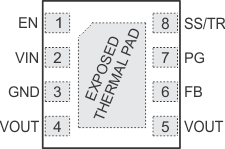SLVSDN4 June 2017 TPS82150
PRODUCTION DATA.
- 1 Features
- 2 Applications
- 3 Description
- 4 Revision History
- 5 Pin Configuration and Functions
- 6 Specifications
- 7 Detailed Description
- 8 Application and Implementation
- 9 Power Supply Recommendations
- 10Layout
- 11Device and Documentation Support
- 12Mechanical, Packaging, and Orderable Information
Package Options
Mechanical Data (Package|Pins)
- SIL|8
Thermal pad, mechanical data (Package|Pins)
Orderable Information
5 Pin Configuration and Functions
space
8-Pin µSiL Package
(SIL0008C Top View)

space
Pin Functions
| PIN | I/O | DESCRIPTION | |
|---|---|---|---|
| NAME | NO. | ||
| EN | 1 | I | Enable pin. Pull High to enable the device. Pull Low to disable the device. This pin has an internal pull-down resistor of typically 400kΩ when the device is disabled. |
| VIN | 2 | PWR | Input pin. |
| GND | 3 | Ground pin. | |
| VOUT | 4,5 | PWR | Output pin. |
| FB | 6 | I | Feedback reference pin. An external resistor divider connected to this pin programs the output voltage. |
| PG | 7 | O | Power good open drain output pin. A pull-up resistor can be connected to any voltage less than 6V. Leave it open if it is not used. |
| SS/TR | 8 | I | Soft startup and voltage tracking pin. An external capacitor connected to this pin sets the internal reference voltage rising time. |
| Exposed Thermal Pad | The exposed thermal pad must be connected to the GND pin. Must be soldered to achieve appropriate power dissipation and mechanical reliability. | ||